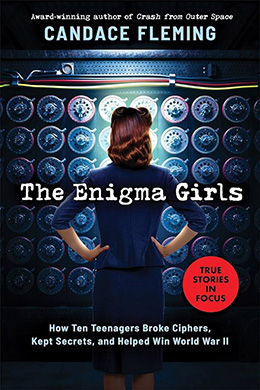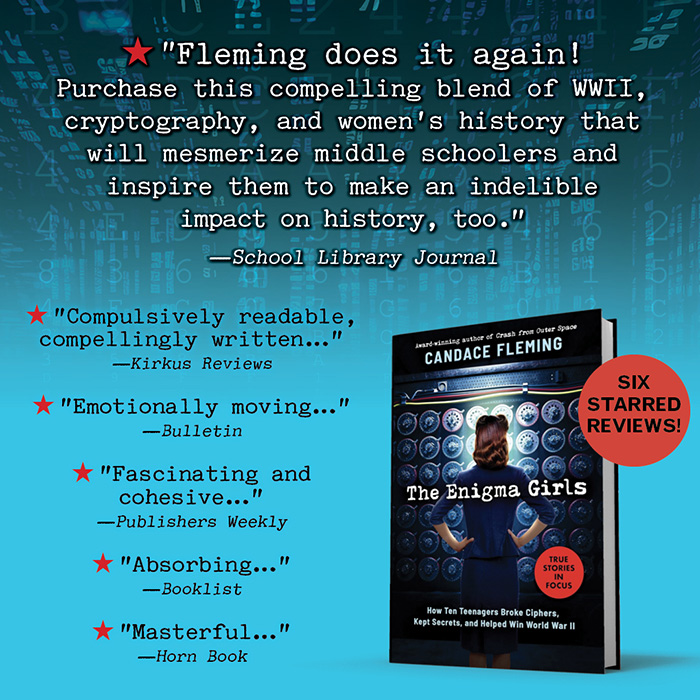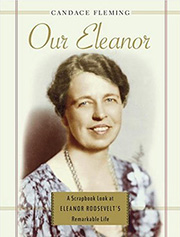BOOKS

Scholastic Focus
March 5, 2024
978–1338749571
ages 8 and up
buy the book
hardcover
e‑book
audio book
After you’ve read The Enigma Girls, try this book:
The Enigma Girls
How Ten Teenagers Broke Ciphers, Kept Secrets, and Helped Win World War II
“You are to report to Station X at Bletchley Park, Buckinghamshire, in four days time.…That is all you need to know.” This was the terse telegram hundreds of young women throughout the British Isles received in the spring of 1941, as World War II raged. As they arrived at Station X, a sprawling mansion in a state of disrepair surrounded by Spartan-looking huts with little chimneys coughing out thick smoke — these young people had no idea what kind of work they were stepping into. Who had recommended them? Why had they been chosen? Most would never learn all the answers to these questions.
Bletchley Park was a well-kept secret during World War II, operating under the code name Station X. The critical work of code-cracking Nazi missives that went on behind its closed doors could determine a victory or loss against Hitler’s army. Amidst the brilliant cryptographers, flamboyant debutantes, and absent-minded professors working there, it was teenaged girls who kept Station X running. Some could do advanced math, while others spoke a second language. They ran the unwieldy bombe machines, made sense of wireless sound waves, and sorted the decoded messages. They were expected to excel in their fields and most importantly: know how to keep a secret.
Awards and Honors
- ALSC Notable Children’s Books, Older
- Bank Street College of Education Best Children’s Books 2025
- BCCB Blue Ribbon
- Booklist Editor’s Choice
- CBC Best Stem Books 2025
- The Horn Book Best Books
- International Youth Library White Ravens Catalogue 2025
- Mathical Honor Book 2025
- New York Public Library Best Books
- Kirkus Reviews Best Books
- Robert F. Sibert Honor Book 2025
- School Library Journal Best Books
- Texas Topaz Nonfiction Reading List 2025
- YALSA Amazing Audio Books, Top Ten
- YALSA Quick Picks Book List, Top Ten
Resource
“Homefront Heroines: New Kids’ Books Explore Hidden Wartime History,” Emma Kantor, Publishers Weekly, 14 May 2024

Reviews
“Fleming captures the emotional and psychological burdens that these teenagers carried and balances it with detailed descriptions of the technology used to carry out their lifesaving tasks. The narrative is broken up by copious black-and-white photographs of the rooms the Wrens worked in; important figures of the time, such as Winston Churchill; the machines they worked on; and other wartime events. The work features a bibliography, source notes, index, and more. VERDICT Fleming does it again! Purchase this compelling blend of WWII, cryptography, and women’s history that will mesmerize middle schoolers and inspire them to make an indelible impact on history, too. (School Library Journal, starred review)
“Fleming’s account focuses on ten such young women (one of whom is an offsite radio operator) but, in a masterful presentation of related subject matter, seamlessly intersperses segments on larger historical events, beginning with the Battle of Britain and concluding with V‑J Day; clear and thorough explanations of codes and ciphers; and technical advances that led to the use of computers. The girls’ personal experiences, from coping with housing shortages, to falling in love, to discovering their future life’s work, adds another dimension. Amid the often-tedious work of breaking the ciphers, moments of humanity appear: the joy of pinpointing an enemy bombing target on British soil; the recognition that a freshly bloodstained Nazi cipher book meant “somewhere this German airman was still bleeding, dying maybe … That really did bring the war close.” (The Horn Book, starred review)
“This compulsively readable, compellingly written book will appeal to a broad audience, from readers already interested in World War II to those who are new to the subject. The fascinating photos and diagrams invite browsing. A gripping narrative celebrating teen girls’ underrecognized contributions to Allied war efforts. (Kirkus Reviews, starred review)
“In this absorbing book, Fleming approaches the subject by telling the individual stories of 10 young women (most were 18 years old) who left their homes to work secretly on projects related to the German military’s Enigma cipher machine. The book’s many archival photographs offer glimpses of buildings and projects at Bletchley and scenes of men and women working there during the war, as well as pictures of world leaders, landmarks, and ships at sea. Even readers with little interest in codes and ciphers will find the women’s experiences intriguing. Fleming organizes the material well and provides extensive source notes. The book explores the Enigma girls’ lives and the importance of their war work, while showing that their choices, actions, and achievements helped the Allies change the course of history. (Booklist, starred review)
“Quick-paced, thoroughly researched chapters subsequently intersperse a survey of WWII movements with specifics about Bletchley Park’s operations and individuals’ assigned tasks, including listening for encrypted Morse code messages, breaking ciphers, translating and indexing information, and working revolutionary machines such as the Bombes and the Colossus. In following the 10 teens’ often painstaking experiences, Fleming delivers a fascinating and cohesive overview of Bletchley Park’s necessarily siloed, collaborative inner workings that reveals how the figures’ ardent efforts affected the outcome of WWII. Engaging interstitials tackle the nuts and bolts of ciphers, clues, codes, and cribs, and b&w photograph reproductions help anchor era-specific information. (Publishers Weekly, starred review)
“Interweaving the stories of these young women with major WWII events offers a unique perspective on wartime, describing the ordinary and repetitive clerical work that contributes and connects to the historic moments. While keeping the harsh reality of war present, Fleming includes small, humanizing aspects of the girls’ lives, like how Patricia joined the Women’s Royal Naval Service primarily because she liked their stylish uniforms. The result is a fascinating and emotionally moving perspective on the well-trod ground of WWII, carefully balanced and rich with details of technology, history, and humanity. (Bulletin of the Center for Children’s Books, starred review)
“This is the story of a handful of young women — teenagers really — who left their childhoods behind and walked into the unknown,” Candace Fleming writes in “The Enigma Girls,” her beguiling new account of their contributions. “For most of their lives, they never breathed a word about their war experiences.” (The New York Times Book Review)


